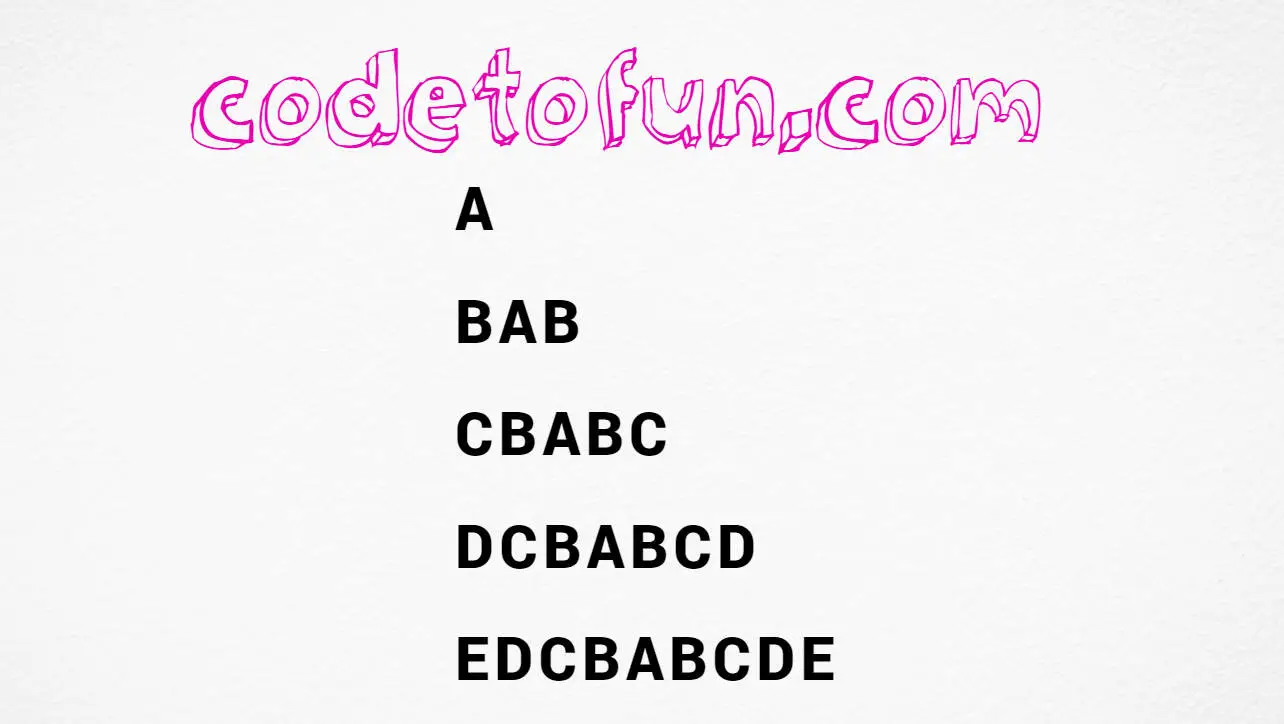
Java Topics
- Java Intro
- Java String Methods
- Java Interview Programs
- Java Star Pattern
- Java Number Pattern
- Java Alphabet Pattern
- Alphabet Pattern 1
- Alphabet Pattern 2
- Alphabet Pattern 3
- Alphabet Pattern 4
- Alphabet Pattern 5
- Alphabet Pattern 6
- Alphabet Pattern 7
- Alphabet Pattern 8
- Alphabet Pattern 9
- Alphabet Pattern 10
- Alphabet Pattern 11
- Alphabet Pattern 12
- Alphabet Pattern 13
- Alphabet Pattern 14
- Alphabet Pattern 15
- Alphabet Pattern 16
- Alphabet Pattern 17
- Alphabet Pattern 18
- Alphabet Pattern 19
- Alphabet Pattern 20
- Alphabet Pattern 21
- Alphabet Pattern 22
- Alphabet Pattern 23
- Alphabet Pattern 24
- Alphabet Pattern 25
- Alphabet Pattern 26
- Alphabet Pattern 27
- Alphabet Pattern 28
- Alphabet Pattern 29
- Alphabet Pattern 30
- Alphabet Pattern 31
- Alphabet Pattern 32
- Alphabet Pattern 33
- Alphabet Pattern 34
Java Alphabet Pattern 24

Photo Credit to CodeToFun
Java Alphabet Pattern 24
Here`s a program that prints the above alphabet pattern using Java Programming:
public class Demo
{
public static void main(String[] args)
{
int i, j;
for(i=65; i<=69; i++)
{
for(j=i; j>65; j--)
System.out.format("%c", j);
for(j=65; j<=i; j++)
System.out.format("%c", j);
System.out.println();
}
}
}💻 Testing the Program
When you run the above program, it will print the following output:
A BAB CBABC DCBABCD EDCBABCDE
🧠 How the Program Works
Let's break down the logic behind the code:
- public class Demo: This line declares a public class named "Demo." In Java, every program must have a class with a main method to be executed.
- public static void main(String[] args): This is the main method, which serves as the entry point for the program. It takes an array of strings as its argument but doesn't use it in this case.
- Inside the main method, two integer variables i and j are declared.
- The outer loop: for(i=65; i<=69; i++) - This loop iterates through values of i from 65 to 69. These values correspond to ASCII characters 'A' to 'E'.
- The first inner loop: for(j=i; j>65; j--) - This loop runs from the current value of i (which starts at 'A') down to 66 ('B'). It prints characters in descending order.
- The System.out.format("%c", j); statement inside the first inner loop prints the character represented by the ASCII value j.
- The second inner loop: for(j=65; j<=i; j++) - This loop runs from 'A' to the current value of i. It prints characters in ascending order.
- The System.out.format("%c", j); statement inside the second inner loop prints the character represented by the ASCII value j.
- After the inner loops, there's a System.out.println(); statement, which moves to the next line. This creates a new line for each row of the pyramid.
- The outer loop continues until i reaches 69 ('E'), and the inner loops and line break are repeated for each iteration.
💯 Tips for Enhancement:
Explore the versatility of this pattern by adjusting its parameters. Whether you increase or decrease the size, tweak the spacing, or modify the characters used, each change opens up a world of possibilities, allowing you to customize and create your unique visual effects.
✔ Conclusion:
Creating visually appealing patterns is not only a fun endeavour but also a great way to enhance your programming or design skills. We hope this tutorial has inspired you to explore the world of creative coding. Share your creations with us, and let your imagination run wild!
🤗 Closing Call-to-Action:
We'd love to see your unique interpretations of the alphabet pattern. Share your creations in the comments below, and don't hesitate to reach out if you have any questions or suggestions for future tutorials. Happy coding!
👨💻 Join our Community:
Author

For over eight years, I worked as a full-stack web developer. Now, I have chosen my profession as a full-time blogger at codetofun.com.
Buy me a coffee to make codetofun.com free for everyone.
Buy me a CoffeeShare Your Findings to All
Recent Post in Java














If you have any doubts regarding this article (Java Alphabet Pattern 24), please comment here. I will help you immediately.